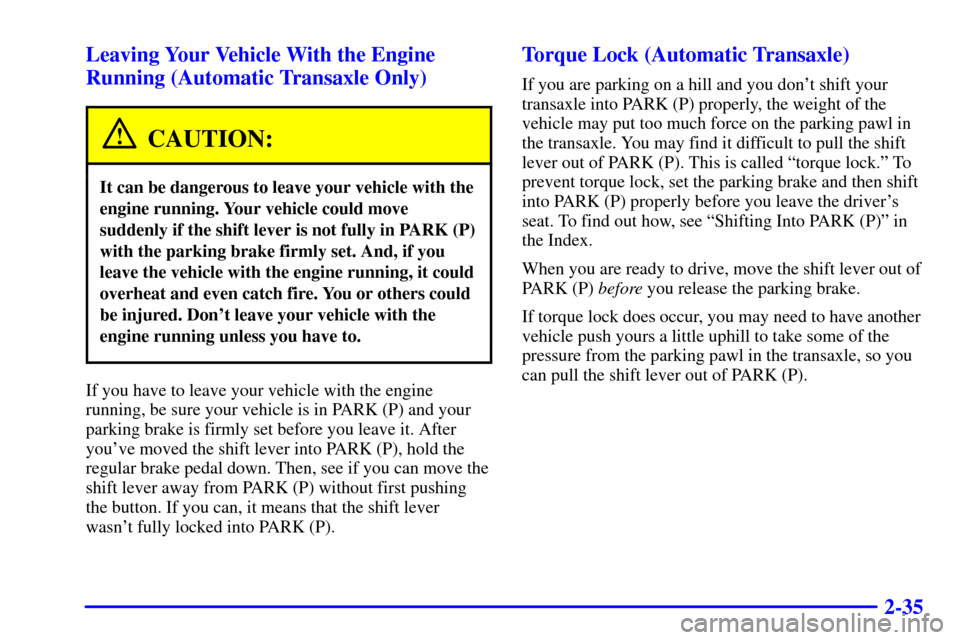Page 62 of 360

2-
2-1
Section 2 Features and Controls
Here you can learn about the many standard and optional features on your vehicle, and information on starting,
shifting and braking. Also explained are the instrument panel and the warning systems that tell you if everything is
working properly
-- and what to do if you have a problem.
2
-2 Windows
2
-4 Keys
2
-6 Door Locks
2
-8 Remote Keyless Entry (If Equipped)
2
-13 Trunk
2
-16 Theft
2
-17 Content Theft Security System (If Equipped)
2
-18 Passlock�
2-19 New Vehicle ªBreak-Inº
2
-19 Ignition Positions
2
-22 Starting Your Engine
2
-25 Engine Coolant Heater (If Equipped)
2
-27 Automatic Transaxle Operation
2
-30 Manual Transaxle Operation
2
-33 Parking Brake
2
-34 Shifting Into PARK (P)
(Automatic Transaxle Only)
2
-36 Shifting Out of PARK (P)
(Automatic Transaxle Only)2
-36 Parking Your Vehicle
(Manual Transaxle Models Only)
2
-37 Parking Over Things That Burn
2
-37 Engine Exhaust
2
-38 Running Your Engine While You're Parked
(Automatic Transaxle)
2
-39 Tilt Wheel (If Equipped)
2
-39 Turn Signal/Multifunction Lever
2
-45 Exterior Lamps
2
-48 Interior Lamps
2
-49 Mirrors
2
-52 Storage Compartments
2
-53 Ashtrays and Cigarette Lighter (If Equipped)
2
-53 Sun Visors
2
-55 Sunroof (If Equipped)
2
-56 The Instrument Panel -- Your
Information System
2
-58 Instrument Panel Cluster
2
-60 Warning Lights, Gages and Indicators
Page 75 of 360

2-14 Remote Trunk Release
Press the remote trunk release button, located on the
lower left side of the instrument panel, to release the
trunk lid.
If your vehicle is equipped with the remote keyless entry
system, the daytime running lamps will flash twice.
Make sure the remote trunk release lockout feature is
not activated. Also, the remote trunk release will only
work when either the ignition is in OFF or
ACCESSORY, the parking brake is engaged or the
vehicle speed is less than 2 mph (3 km/h).
Remote Trunk Release Lockout
Your remote trunk release is equipped with a lockout
feature. The switch is located on the inside of the trunk
lid, mounted to the trunk lid latch.
To turn the lockout on, slide the switch all the way to the
left to ON. To turn the lockout off, slide the switch all
the way to the right to OFF.
When the lockout is on, the remote trunk release button
will not release the trunk lid. However, the trunk lid can
still be opened with the key, but not with the keyless
entry transmitter (if equipped).
Page 83 of 360

2-22 Retained Accessory Power (RAP)
Your vehicle is equipped with a Retained Accessory
Power (RAP) feature which will allow the radio to
continue to work up to 10 minutes after the ignition is
turned to OFF.
Your radio will work when the ignition key is in RUN or
ACCESSORY. Once the key is turned from RUN to
OFF, the radio will continue to work for up to 10
minutes or until the driver's door is opened.
Starting Your Engine
Automatic Transaxle
Move your shift lever to PARK (P) or NEUTRAL (N).
Your engine won't start in any other position
-- that's a
safety feature. To restart when you're already moving,
use NEUTRAL (N) only.
NOTICE:
Don't try to shift to PARK (P) if your vehicle is
moving. If you do, you could damage the
transaxle. Shift to PARK (P) only when your
vehicle is stopped.
Manual Transaxle
The gear selector should be in neutral and the parking
brake engaged. Hold the clutch pedal to the floor and
start the engine. Your vehicle won't start if the clutch
pedal is not all the way down
-- that's a safety feature.
Page 88 of 360

2-27
Automatic Transaxle Operation
If your vehicle is equipped with an automatic
transaxle, the shift lever is located on the console
between the seats.
There are seven positions for the four
-speed automatic
transaxle. See ªForward Gearsº later in this section.
PARK (P): This position locks your front wheels. It's
the best position to use when you start your engine
because your vehicle can't move easily.
CAUTION:
It is dangerous to get out of your vehicle if the
shift lever is not fully in PARK (P) with the
parking brake firmly set. Your vehicle can roll.
Don't leave your vehicle when the engine is
running unless you have to. If you have left the
engine running, the vehicle can move suddenly.
CAUTION: (Continued)
CAUTION: (Continued)
You or others could be injured. To be sure your
vehicle won't move, even when you're on fairly
level ground, always set your parking brake and
move the shift lever to PARK (P).
See ªShifting Into PARK (P)º in the Index.
If you're pulling a trailer, see ªTowing a Trailerº
in the Index.
Ensure the shift lever is fully in PARK (P) before
starting the engine. Your vehicle has an automatic
transaxle shift lock control system. You have to fully
apply your regular brakes before you can shift from
PARK (P) when the ignition key is in RUN. If you
cannot shift out of PARK (P), ease pressure on the shift
lever
-- push the shift lever all the way into PARK (P)
and also release the shift lever button on floor shift
console models as you maintain brake application. Then
move the shift lever into the gear you wish. (Press the
shift lever button before moving the shift lever.) See
ªShifting Out of PARK (P)º in the Index.
Page 92 of 360

2-31
SECOND (2): Press the clutch pedal as you let up on
the accelerator pedal and shift into SECOND (2). Then,
slowly let up on the clutch pedal as you press the
accelerator pedal.
THIRD (3), FOURTH (4) and FIFTH (5): Shift into
THIRD (3), FOURTH (4) and FIFTH (5), the same way
you do for SECOND (2). Slowly let up on the clutch
pedal as you press the accelerator pedal.
To stop, let up on the accelerator pedal and press
the brake pedal. Just before the vehicle stops, press
the clutch pedal and the brake pedal, and shift
to NEUTRAL (N).
NEUTRAL (N): Use this position when you start or
idle your engine.REVERSE (R): To back up, press down the clutch
pedal, lift up the ring on the shift lever and shift into
REVERSE (R). Let up on the clutch pedal slowly while
pressing the accelerator pedal.
NOTICE:
Shift to REVERSE (R) only after your vehicle is
stopped. Shifting to REVERSE (R) while your
vehicle is moving could damage your transaxle.
Also, use REVERSE (R), along with the parking brake,
for parking your vehicle.
Page 94 of 360
2-33
Parking Brake
Manual shown, Automatic similar
The parking brake lever is located between the
bucket seats.To set the parking brake, hold the brake pedal down and
pull up on the parking brake lever. If the ignition is on,
the brake system warning light will come on.
To release the parking brake, hold the brake pedal down.
Pull the parking brake lever up until you can press the
release button. Hold the release button in as you move
the brake lever all the way down.
If you forget to release your parking brake prior to
driving away, a chime will sound to remind you to
release the parking brake.
NOTICE:
Driving with the parking brake on can cause
your rear brakes to overheat. You may have to
replace them, and you could also damage other
parts of your vehicle.
Page 95 of 360
2-34
Shifting Into PARK (P)
(Automatic Transaxle Only)
CAUTION:
It can be dangerous to get out of your vehicle if
the shift lever is not fully in PARK (P) with the
parking brake firmly set. Your vehicle can roll. If
you have left the engine running, the vehicle can
move suddenly. You or others could be injured.
To be sure your vehicle won't move, even when
you're on fairly level ground, use the steps that
follow. If you're pulling a trailer, see ªTowing a
Trailerº in the Index.
1. Hold the brake pedal down and set the
parking brake.
2. Move the shift lever into the PARK (P) position
like this:
�Hold in the button on the shift lever.
�Push the lever all the way toward the front of
your vehicle.
3. Turn the ignition key to LOCK.
4. Remove the key and take it with you. If you can
leave your vehicle with the ignition key in your
hand, your vehicle is in PARK (P).
Page 96 of 360

2-35 Leaving Your Vehicle With the Engine
Running (Automatic Transaxle Only)
CAUTION:
It can be dangerous to leave your vehicle with the
engine running. Your vehicle could move
suddenly if the shift lever is not fully in PARK (P)
with the parking brake firmly set. And, if you
leave the vehicle with the engine running, it could
overheat and even catch fire. You or others could
be injured. Don't leave your vehicle with the
engine running unless you have to.
If you have to leave your vehicle with the engine
running, be sure your vehicle is in PARK (P) and your
parking brake is firmly set before you leave it. After
you've moved the shift lever into PARK (P), hold the
regular brake pedal down. Then, see if you can move the
shift lever away from PARK (P) without first pushing
the button. If you can, it means that the shift lever
wasn't fully locked into PARK (P).
Torque Lock (Automatic Transaxle)
If you are parking on a hill and you don't shift your
transaxle into PARK (P) properly, the weight of the
vehicle may put too much force on the parking pawl in
the transaxle. You may find it difficult to pull the shift
lever out of PARK (P). This is called ªtorque lock.º To
prevent torque lock, set the parking brake and then shift
into PARK (P) properly before you leave the driver's
seat. To find out how, see ªShifting Into PARK (P)º in
the Index.
When you are ready to drive, move the shift lever out of
PARK (P) before you release the parking brake.
If torque lock does occur, you may need to have another
vehicle push yours a little uphill to take some of the
pressure from the parking pawl in the transaxle, so you
can pull the shift lever out of PARK (P).